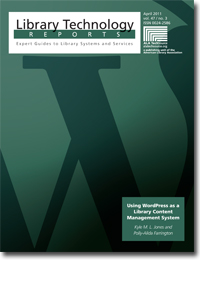Kyle Jones interviewed Kenley Neufeld and me for the new Library technology report from ALA TechSource: “Using WordPress as a Library Content Management System” by Kyle M. L. Jones and Polly-Alida Farrington.
Here’s a snippet:
 KJ: You both work at institutions where you have some kind of formal learning management system. Why did you make the decision to not use the resources you had? You could have made your lives extremely easier going with the norm and instead you chose to roll your own. You put a lot of struggles on yourself to do so.
KJ: You both work at institutions where you have some kind of formal learning management system. Why did you make the decision to not use the resources you had? You could have made your lives extremely easier going with the norm and instead you chose to roll your own. You put a lot of struggles on yourself to do so.
MS: I can’t have my students spend so much time creating and writing inside a tool that they’ll probably never touch once they graduate, unless maybe they work in academic libraries. They should be using a tool or a handful of tools they will be using in their jobs. I want them to come out of the program and say they have used WordPress and took advanced web design and experienced Drupal and used Twitter. That’s much more important than these systems. The feeling that I’m serving the students better by using these systems is good.
KN: For me, it’s been more about trying to build tools that will meet the needs of the types of things I want incorporated. The system we had originally, WebCT, I used for only one semester and was very disappointed. As a result, I started using Moodle the following term and then the college went to Moodle as well (thankfully). I do use Moodle, and it works well for the most part, but I found it a little bit clunky here and there for some things I’m trying to accomplish.
The main reason I’m using WordPress/BuddyPress is because the class I’m teaching has to do with social media. Since the class focus is social media and social networking, it seemed like the obvious solution would be to actually use the tools that I’m teaching about. It was a non-decision. This is what we’re going to use and I’ve been very happy. Now, as I look ahead, and if I were to teach other classes without the heavy social media focus, then I would still be inclined toward using the WordPress/BuddyPress solution. I am comfortable with it and happy with it. But I also need to think about the overall student experience and recognize that the school does support one system, which is Moodle, and rather than have students learn a new system, it may be smarter to stick with Moodle. It would really depend on the class. In the current situation, WordPress is the obvious solution.
Fortunately, learning management systems are trying to incorporate more of the social media tools where you can easily incorporate the video and the audio; the interactivity and visual representations that people seek. I haven’t looked at Blackboard in a couple years, so I’m not that familiar with it, but with Moodle you can incorporate just about anything. There are methods to do it, but you are still building within a framework though it is customizable. It will depend on the support you have locally because most instructors are not going to go the extra step unless they have an easy mechanism in order to do so. On our campus we are working in that direction — to support instructors to add other types of media content, interactively, to allow for a richer learning environment. It is possible.
MS: I taught 25-students last summer using WordPress/BuddyPress doing Internet Fundamentals. What Kenley said about media is incredibly important and this summer I would be out on the hiking trail with the dog and my iPhone. I’d be thinking about what I’d like to tell the students, so I recorded a video that isn’t just a talking head. They see a tree going by, or the lake, or the dog, and they hear my voice saying they are doing really great and here are some things to think about while doing this next exercise. And the feedback I got from the students for a 3-minute video was that they loved it. It helped them feel connected and it helped me feel more connected with them. It became part of what we were doing.
Please take a look at the whole post and don’t miss the new report from authors Kyle M. L. Jones and Polly-Alida Farrington.
